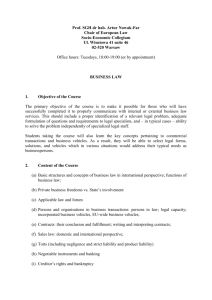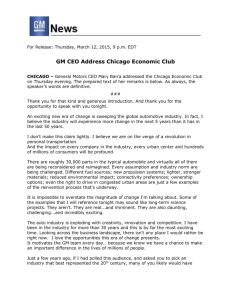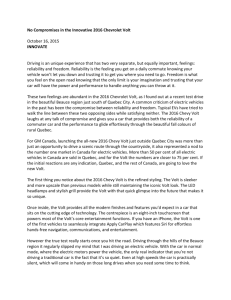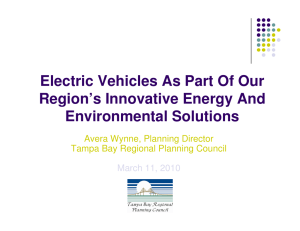Transforming the Auto Industry - The Earth Institute
advertisement
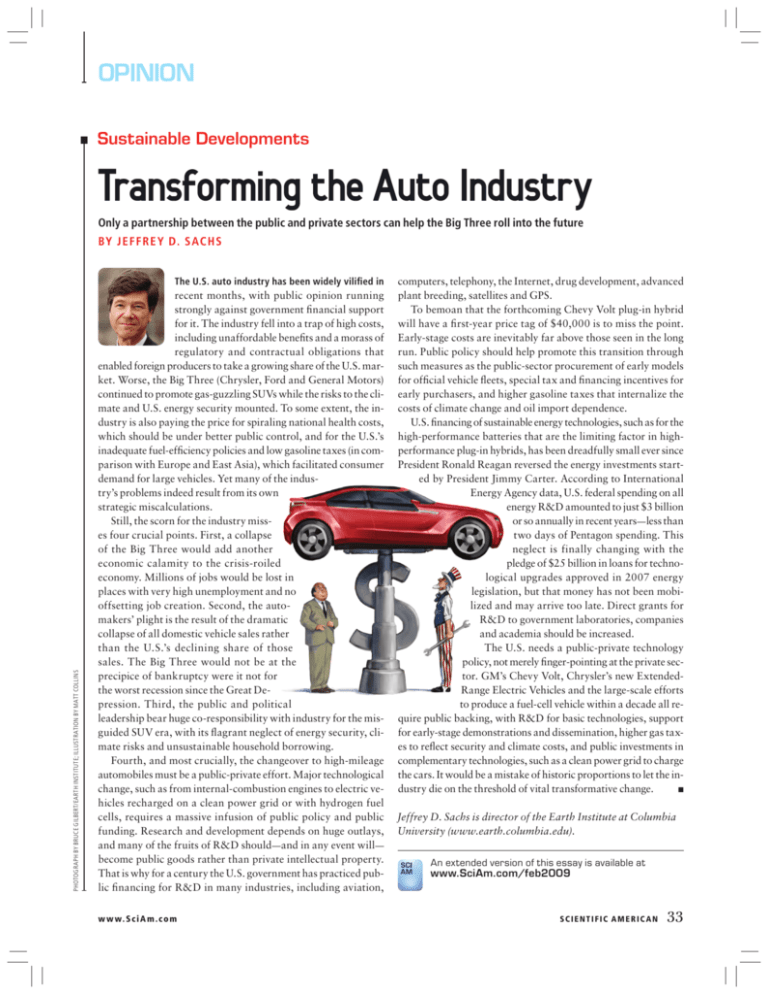
OPINION Sustainable Developments Transforming the Auto Industry Only a partnership between the public and private sectors can help the Big Three roll into the future BY J E FFR E Y D. SAC H S PHOTOGRAPH BY BRUCE GILBERT/EARTH INSTITUTE; ILLUSTRATION BY MATT COLLINS The U.S. auto industry has been widely vilified in recent months, with public opinion running strongly against government fi nancial support for it. The industry fell into a trap of high costs, including unaffordable benefits and a morass of regulatory and contractual obligations that enabled foreign producers to take a growing share of the U.S. market. Worse, the Big Three (Chrysler, Ford and General Motors) continued to promote gas-guzzling SUVs while the risks to the climate and U.S. energy security mounted. To some extent, the industry is also paying the price for spiraling national health costs, which should be under better public control, and for the U.S.’s inadequate fuel-efficiency policies and low gasoline taxes (in comparison with Europe and East Asia), which facilitated consumer demand for large vehicles. Yet many of the industry’s problems indeed result from its own strategic miscalculations. Still, the scorn for the industry misses four crucial points. First, a collapse of the Big Three would add another economic calamity to the crisis-roiled economy. Millions of jobs would be lost in places with very high unemployment and no offsetting job creation. Second, the automakers’ plight is the result of the dramatic collapse of all domestic vehicle sales rather than the U.S.’s declining share of those sales. The Big Three would not be at the precipice of bankruptcy were it not for the worst recession since the Great Depression. Third, the public and political leadership bear huge co-responsibility with industry for the misguided SUV era, with its flagrant neglect of energy security, climate risks and unsustainable household borrowing. Fourth, and most crucially, the changeover to high-mileage automobiles must be a public-private effort. Major technological change, such as from internal-combustion engines to electric vehicles recharged on a clean power grid or with hydrogen fuel cells, requires a massive infusion of public policy and public funding. Research and development depends on huge outlays, and many of the fruits of R&D should— and in any event will— become public goods rather than private intellectual property. That is why for a century the U.S. government has practiced public fi nancing for R&D in many industries, including aviation, w w w. S c i A m . c o m computers, telephony, the Internet, drug development, advanced plant breeding, satellites and GPS. To bemoan that the forthcoming Chevy Volt plug-in hybrid will have a fi rst-year price tag of $40,000 is to miss the point. Early-stage costs are inevitably far above those seen in the long run. Public policy should help promote this transition through such measures as the public-sector procurement of early models for official vehicle fleets, special tax and fi nancing incentives for early purchasers, and higher gasoline taxes that internalize the costs of climate change and oil import dependence. U.S. financing of sustainable energy technologies, such as for the high-performance batteries that are the limiting factor in highperformance plug-in hybrids, has been dreadfully small ever since President Ronald Reagan reversed the energy investments started by President Jimmy Carter. According to International Energy Agency data, U.S. federal spending on all energy R&D amounted to just $3 billion or so annually in recent years— less than two days of Pentagon spending. This neglect is finally changing with the pledge of $25 billion in loans for technological upgrades approved in 2007 energy legislation, but that money has not been mobilized and may arrive too late. Direct grants for R&D to government laboratories, companies and academia should be increased. The U.S. needs a public-private technology policy, not merely finger-pointing at the private sector. GM’s Chevy Volt, Chrysler’s new ExtendedRange Electric Vehicles and the large-scale efforts to produce a fuel-cell vehicle within a decade all require public backing, with R&D for basic technologies, support for early-stage demonstrations and dissemination, higher gas taxes to reflect security and climate costs, and public investments in complementary technologies, such as a clean power grid to charge the cars. It would be a mistake of historic proportions to let the industry die on the threshold of vital transformative change. ■ Jeffrey D. Sachs is director of the Earth Institute at Columbia University (www.earth.columbia.edu). An extended version of this essay is available at www.SciAm.com/feb2009 SCIENTIFIC AMERICAN 33





